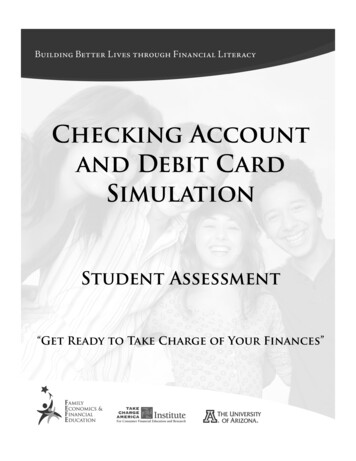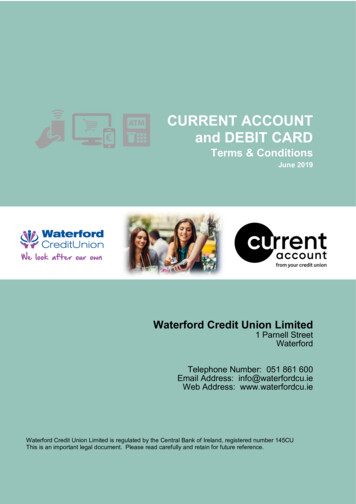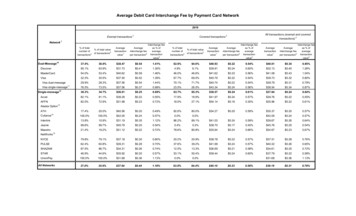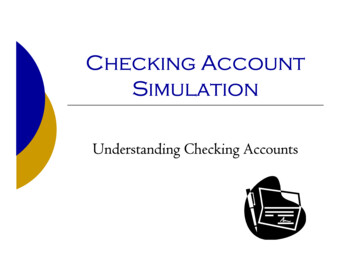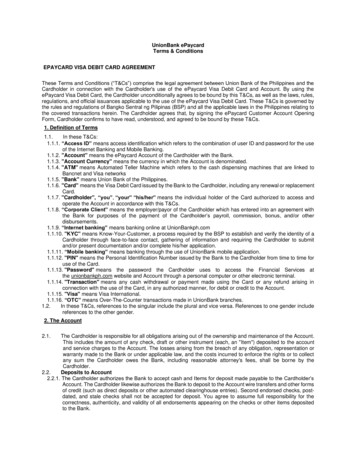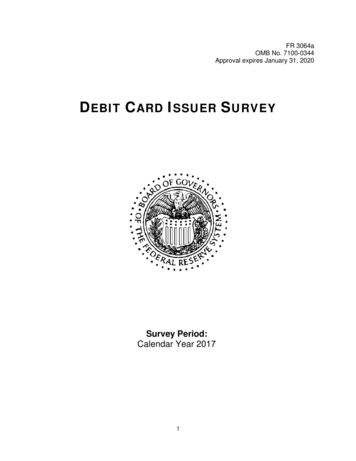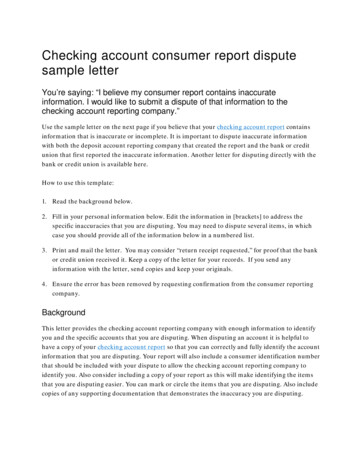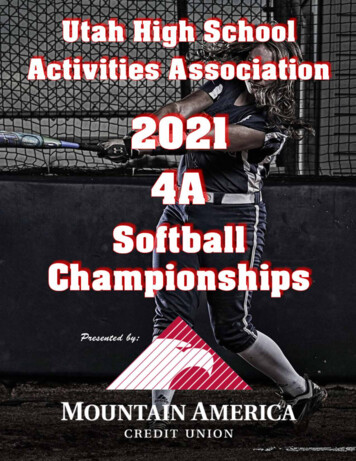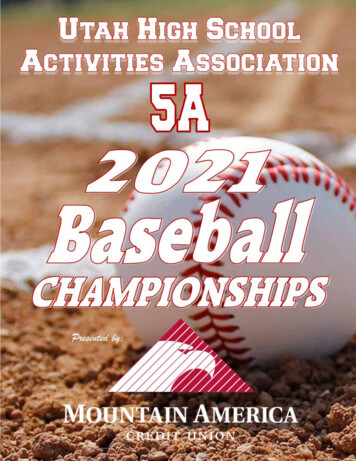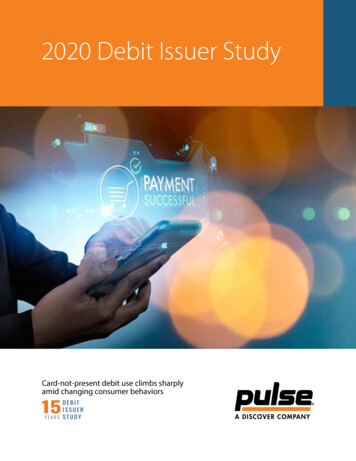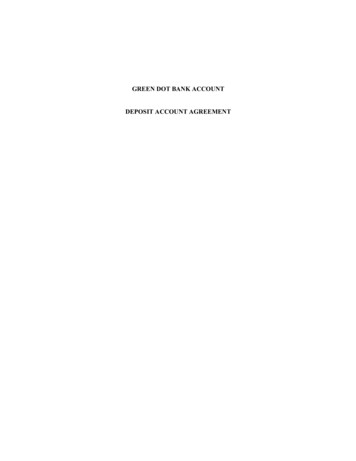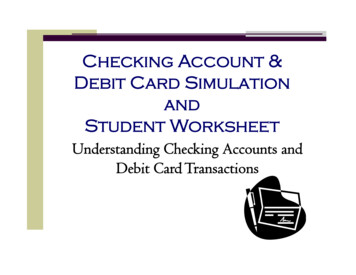
Transcription
Checking Account &Debit Card SimulationandStudent WorksheetUnderstanding Checking Accounts andDebit Card Transactions
2.7.3.G1What is a CheckingAccount? Common financial service used by many consumersFunds are easily accessed CheckATM (automated teller machine)Debit cardTelephoneInternetServices and fees vary depending upon the financialinstitution Family Economics & Financial Education – May 2006 – Get Ready to Take Charge of Your Finances – Checking Account & Debit Card SimulationFunded by a grant from Take Charge America, Inc. to the Norton School of Family and Consumer Sciences at the University of Arizona
2.7.3.G1Why Do People UseChecking Accounts? Reduces the need to carry large amounts of cashConvenience – useful for paying billsSpending Plan Tool Keeps a record of where money is spentSafety – using checks is safer than carrying cash Family Economics & Financial Education – May 2006 – Get Ready to Take Charge of Your Finances – Checking Account & Debit Card SimulationFunded by a grant from Take Charge America, Inc. to the Norton School of Family and Consumer Sciences at the University of Arizona
2.7.3.G1What is a Check? Used at the time of purchase as the form of payment Piece of paper pre-printed with the account holder’s: NameAddressFinancial institutionIdentification numbers Family Economics & Financial Education – May 2006 – Get Ready to Take Charge of Your Finances – Checking Account & Debit Card SimulationFunded by a grant from Take Charge America, Inc. to the Norton School of Family and Consumer Sciences at the University of Arizona
2.7.3.G1Bouncing a Check Check written for an amount over the current balanceheld in the account ‘Bounces’ due to insufficient funds, or not enough money inthe account to cover the check writtenA fee will be charged to the account holderHarm future opportunities for credit Family Economics & Financial Education – May 2006 – Get Ready to Take Charge of Your Finances – Checking Account & Debit Card SimulationFunded by a grant from Take Charge America, Inc. to the Norton School of Family and Consumer Sciences at the University of Arizona
2.7.3.G1Other CheckingComponents Checking Account Register Place to immediately record all monetary transactions fora checking account Written checks, ATM withdrawals, debit card purchases,deposits and additional bank feesCheckbook Contains the checks and the register to track monetarytransactions Family Economics & Financial Education – May 2006 – Get Ready to Take Charge of Your Finances – Checking Account & Debit Card SimulationFunded by a grant from Take Charge America, Inc. to the Norton School of Family and Consumer Sciences at the University of Arizona
2.7.3.G1ATMAutomated teller machine, or a cash machine Can be used to withdraw cash and make deposits Additional fees may be assessed if the ATMused is not provided by the financial institutionsponsoring the card Family Economics & Financial Education – May 2006 – Get Ready to Take Charge of Your Finances – Checking Account & Debit Card SimulationFunded by a grant from Take Charge America, Inc. to the Norton School of Family and Consumer Sciences at the University of Arizona
2.7.3.G1Debit Card Plastic card that looks like a credit cardElectronically connected to a bank accountMoney is automatically taken from the bank accountwhen purchases are madeRequires a PIN (personal identification number) Confirms the user is authorized to access the account Family Economics & Financial Education – May 2006 – Get Ready to Take Charge of Your Finances – Checking Account & Debit Card SimulationFunded by a grant from Take Charge America, Inc. to the Norton School of Family and Consumer Sciences at the University of Arizona
2.7.3.G1To Use A Debit Card Swipe it through the store machine or put into anATMEnter the PINComplete transaction Family Economics & Financial Education – May 2006 – Get Ready to Take Charge of Your Finances – Checking Account & Debit Card SimulationFunded by a grant from Take Charge America, Inc. to the Norton School of Family and Consumer Sciences at the University of Arizona
2.7.3.G1Pros and Cons - Debit CardsPros ConvenientSmallCan be used like acredit cardAllows a person tocarry less cashDoes not allowoverspendingCons Can lose track of balance iftransactions are not written downOpens checking account up to creditfraudOthers can gain access to the accountif the card is lost and PIN is known Family Economics & Financial Education – May 2006 – Get Ready to Take Charge of Your Finances – Checking Account & Debit Card SimulationFunded by a grant from Take Charge America, Inc. to the Norton School of Family and Consumer Sciences at the University of Arizona
2.7.3.G1Endorsing a Check Endorsement Signature on the back of a check to approve it to bedeposited or cashedA check must be endorsed to be depositedThree types BlankRestrictiveSpecial Family Economics & Financial Education – May 2006 – Get Ready to Take Charge of Your Finances – Checking Account & Debit Card SimulationFunded by a grant from Take Charge America, Inc. to the Norton School of Family and Consumer Sciences at the University of Arizona
2.7.3.G1Blank Endorsement Receiver of the check signshis/her nameAnyone can cash or depositthe check after has beensigned Family Economics & Financial Education – May 2006 – Get Ready to Take Charge of Your Finances – Checking Account & Debit Card SimulationFunded by a grant from Take Charge America, Inc. to the Norton School of Family and Consumer Sciences at the University of Arizona
2.7.3.G1Restrictive Endorsement More secure than blankendorsementReceiver writes “fordeposit only” and accountnumber above his/hersignature Allows the check to only bedeposited Family Economics & Financial Education – May 2006 – Get Ready to Take Charge of Your Finances – Checking Account & Debit Card SimulationFunded by a grant from Take Charge America, Inc. to the Norton School of Family and Consumer Sciences at the University of Arizona
2.7.3.G1Special Endorsement Receiver signs and writes“pay to the order of (fill inperson’s name)”Allows the check to betransferred to a secondparty Also known as a two-partycheck Family Economics & Financial Education – May 2006 – Get Ready to Take Charge of Your Finances – Checking Account & Debit Card SimulationFunded by a grant from Take Charge America, Inc. to the Norton School of Family and Consumer Sciences at the University of Arizona
2.7.3.G1Worksheet AnswersBlankRestrictiveEndorse HereXEndorse HereFor Deposit Only—Acct. # 987654321Student’s SignatureXStudent’s SignatureSpecialEndorse HerePay to the Order of Jonathon SmithXStudent’s Signature Family Economics & Financial Education – May 2006 – Get Ready to Take Charge of Your Finances – Checking Account & Debit Card SimulationFunded by a grant from Take Charge America, Inc. to the Norton School of Family and Consumer Sciences at the University of Arizona
2.7.3.G1Making a Deposit Deposit slip Contains the account holder’s account number and allows money(cash or check) to be deposited into the correct accountLocated in the back of the checkbookComplete a deposit slip to make a depositDeposited amount must be recorded in thechecking account register to keep the balancecurrentDeposits can be made at an ATM or with abank teller Family Economics & Financial Education – May 2006 – Get Ready to Take Charge of Your Finances – Checking Account & Debit Card SimulationFunded by a grant from Take Charge America, Inc. to the Norton School of Family and Consumer Sciences at the University of Arizona
2.7.3.G1Completing a DepositSlip Date The date the deposit is being made Family Economics & Financial Education – May 2006 – Get Ready to Take Charge of Your Finances – Checking Account & Debit Card SimulationFunded by a grant from Take Charge America, Inc. to the Norton School of Family and Consumer Sciences at the University of Arizona
2.7.3.G1Completing a DepositSlip Signature Line Sign this line to receive cash back Family Economics & Financial Education – May 2006 – Get Ready to Take Charge of Your Finances – Checking Account & Debit Card SimulationFunded by a grant from Take Charge America, Inc. to the Norton School of Family and Consumer Sciences at the University of Arizona
2.7.3.G1Completing a DepositSlip Cash The total amount of cash being deposited Family Economics & Financial Education – May 2006 – Get Ready to Take Charge of Your Finances – Checking Account & Debit Card SimulationFunded by a grant from Take Charge America, Inc. to the Norton School of Family and Consumer Sciences at the University of Arizona
2.7.3.G1Completing a DepositSlip Checks List each check individually Identify each check on the deposit slip by abbreviating the nameof the check writer Family Economics & Financial Education – May 2006 – Get Ready to Take Charge of Your Finances – Checking Account & Debit Card SimulationFunded by a grant from Take Charge America, Inc. to the Norton School of Family and Consumer Sciences at the University of Arizona
2.7.3.G1Completing a DepositSlip Checks If more checks are beingdeposited than number ofspaces on the front, use thebackList each checkAdd the total, enter it on thefront Family Economics & Financial Education – May 2006 – Get Ready to Take Charge of Your Finances – Checking Account & Debit Card SimulationFunded by a grant from Take Charge America, Inc. to the Norton School of Family and Consumer Sciences at the University of Arizona
2.7.3.G1Completing a DepositSlip Total from Other Side The total amount from all checks listed on the back Family Economics & Financial Education – May 2006 – Get Ready to Take Charge of Your Finances – Checking Account & Debit Card SimulationFunded by a grant from Take Charge America, Inc. to the Norton School of Family and Consumer Sciences at the University of Arizona
2.7.3.G1Completing a DepositSlip Subtotal The total amount of cash and checks Family Economics & Financial Education – May 2006 – Get Ready to Take Charge of Your Finances – Checking Account & Debit Card SimulationFunded by a grant from Take Charge America, Inc. to the Norton School of Family and Consumer Sciences at the University of Arizona
2.7.3.G1Completing a DepositSlip Less Cash Received The amount of cash back being receivedThis amount is not deposited into account Family Economics & Financial Education – May 2006 – Get Ready to Take Charge of Your Finances – Checking Account & Debit Card SimulationFunded by a grant from Take Charge America, Inc. to the Norton School of Family and Consumer Sciences at the University of Arizona
2.7.3.G1Completing a DepositSlip Net Deposit The amount being deposited into the accountTo calculate the amount, subtract the cash received from the subtotal Family Economics & Financial Education – May 2006 – Get Ready to Take Charge of Your Finances – Checking Account & Debit Card SimulationFunded by a grant from Take Charge America, Inc. to the Norton School of Family and Consumer Sciences at the University of Arizona
2.7.3.G1Worksheet Answer Family Economics & Financial Education – May 2006 – Get Ready to Take Charge of Your Finances – Checking Account & Debit Card SimulationFunded by a grant from Take Charge America, Inc. to the Norton School of Family and Consumer Sciences at the University of Arizona
2.7.3.G1Writing a Check To pay for items using a checking account A check is given as a form of paymentMust be completed and given to the person or businessPre-printed items on a check Name and address of account holderName and address of financial institutionCheck numberIdentification numbers (account, routing) Family Economics & Financial Education – May 2006 – Get Ready to Take Charge of Your Finances – Checking Account & Debit Card SimulationFunded by a grant from Take Charge America, Inc. to the Norton School of Family and Consumer Sciences at the University of Arizona
2.7.3.G1Writing a Check Personal Information Account holder’s name and addressMay include a phone number, not requiredDO NOT list a social security number for safety reasons Family Economics & Financial Education – May 2006 – Get Ready to Take Charge of Your Finances – Checking Account & Debit Card SimulationFunded by a grant from Take Charge America, Inc. to the Norton School of Family and Consumer Sciences at the University of Arizona
2.7.3.G1Writing a Check Check Number Numbers used to identify checksPrinted chronologically Family Economics & Financial Education – May 2006 – Get Ready to Take Charge of Your Finances – Checking Account & Debit Card SimulationFunded by a grant from Take Charge America, Inc. to the Norton School of Family and Consumer Sciences at the University of Arizona
2.7.3.G1Writing a Check Date The date the check is written Family Economics & Financial Education – May 2006 – Get Ready to Take Charge of Your Finances – Checking Account & Debit Card SimulationFunded by a grant from Take Charge America, Inc. to the Norton School of Family and Consumer Sciences at the University of Arizona
2.7.3.G1Writing a Check Pay to the Order of The name of the person or business to whom the checkis being written Family Economics & Financial Education – May 2006 – Get Ready to Take Charge of Your Finances – Checking Account & Debit Card SimulationFunded by a grant from Take Charge America, Inc. to the Norton School of Family and Consumer Sciences at the University of Arizona
2.7.3.G1Writing a Check Amount of the Check in Numerals The amount of the check written numerically in the boxWrite the cents smaller and underlineWrite the numbers directly next the dollar sign to prevent someone else from addingnumbers to change the amount Family Economics & Financial Education – May 2006 – Get Ready to Take Charge of Your Finances – Checking Account & Debit Card SimulationFunded by a grant from Take Charge America, Inc. to the Norton School of Family and Consumer Sciences at the University of Arizona
2.7.3.G1Writing a Check Amount of the Check in Words The amount of the check written in words on the second lineStart at the far left of the line, write the amount in words, followed by ‘and’, and theamount of cents over 100; draw a line from the end of the words to the word‘dollars’ Family Economics & Financial Education – May 2006 – Get Ready to Take Charge of Your Finances – Checking Account & Debit Card SimulationFunded by a grant from Take Charge America, Inc. to the Norton School of Family and Consumer Sciences at the University of Arizona
2.7.3.G1Writing a Check Memo Space used to identify the reason for writing a check; optionalGood place to write information requested by a company when paying a bill,generally the account number Family Economics & Financial Education – May 2006 – Get Ready to Take Charge of Your Finances – Checking Account & Debit Card SimulationFunded by a grant from Take Charge America, Inc. to the Norton School of Family and Consumer Sciences at the University of Arizona
2.7.3.G1Writing a Check Signature The account holder’s signature agreeing to the transaction Family Economics & Financial Education – May 2006 – Get Ready to Take Charge of Your Finances – Checking Account & Debit Card SimulationFunded by a grant from Take Charge America, Inc. to the Norton School of Family and Consumer Sciences at the University of Arizona
2.7.3.G1Writing a Check Identification Numbers First - routing numbers to identify the account’s financial institutionSecond - account numberThird - check number Family Economics & Financial Education – May 2006 – Get Ready to Take Charge of Your Finances – Checking Account & Debit Card SimulationFunded by a grant from Take Charge America, Inc. to the Norton School of Family and Consumer Sciences at the University of Arizona
2.7.3.G1Worksheet Answers Family Economics & Financial Education – May 2006 – Get Ready to Take Charge of Your Finances – Checking Account & Debit Card SimulationFunded by a grant from Take Charge America, Inc. to the Norton School of Family and Consumer Sciences at the University of Arizona
2.7.3.G1Worksheet Answers Family Economics & Financial Education – May 2006 – Get Ready to Take Charge of Your Finances – Checking Account & Debit Card SimulationFunded by a grant from Take Charge America, Inc. to the Norton School of Family and Consumer Sciences at the University of Arizona
2.7.3.G1Check 21 Check Clearing for the 21st Century Act (Check 21) When a check is written, the money is automaticallywithdrawn from a bank accountMakes “bouncing checks” difficult Family Economics & Financial Education – May 2006 – Get Ready to Take Charge of Your Finances – Checking Account & Debit Card SimulationFunded by a grant from Take Charge America, Inc. to the Norton School of Family and Consumer Sciences at the University of Arizona
2.7.3.G1Debit Card Account Number—Links all purchases made withthe card to a designated bank accountExpiration Date— The debit card is valid and may beused until this dateCardholder’s Name— The cardholder’s full name iswritten out and displayed.Magnetic Strip— When the debit card is swiped, themagnetic strip automatically withdraws funds fromthe cardholder’s account. Family Economics & Financial Education – May 2006 – Get Ready to Take Charge of Your Finances – Checking Account & Debit Card SimulationFunded by a grant from Take Charge America, Inc. to the Norton School of Family and Consumer Sciences at the University of Arizona
2.7.3.G1Debit Card Authorized Signature— Sign in the signature box on theback of the debit card to authorize payments Should also write, “See ID” in the signature boxEnsures the person using the card is authorized to do soVerification Number—This three digit code is located onthe back of the card in the signature area Help ensure the card is in the cardholder’s possession when makingpurchasesPrevents unauthorized use Family Economics & Financial Education – May 2006 – Get Ready to Take Charge of Your Finances – Checking Account & Debit Card SimulationFunded by a grant from Take Charge America, Inc. to the Norton School of Family and Consumer Sciences at the University of Arizona
2.7.3.G1Checking Account Register Place to record all monetary transactions for achecking account Deposits,checks, ATM use, debit card purchases,additional bank feesUsed to keep a running balance of the account Remember Record every transaction! Family Economics & Financial Education – May 2006 – Get Ready to Take Charge of Your Finances – Checking Account & Debit Card SimulationFunded by a grant from Take Charge America, Inc. to the Norton School of Family and Consumer Sciences at the University of Arizona
2.7.3.G1Check Register Date The date the check was written or transaction was made Family Economics & Financial Education – May 2006 – Get Ready to Take Charge of Your Finances – Checking Account & Debit Card SimulationFunded by a grant from Take Charge America, Inc. to the Norton School of Family and Consumer Sciences at the University of Arizona
2.7.3.G1Check Register Number The number of the written check; if a debit card or ATMwas used, write DC or ATM Family Economics & Financial Education – May 2006 – Get Ready to Take Charge of Your Finances – Checking Account & Debit Card SimulationFunded by a grant from Take Charge America, Inc. to the Norton School of Family and Consumer Sciences at the University of Arizona
2.7.3.G1Check Register Description of Transaction The person/business the check was written to or where the debit card wasusedGray line can be used to write the memo Family Economics & Financial Education – May 2006 – Get Ready to Take Charge of Your Finances – Checking Account & Debit Card SimulationFunded by a grant from Take Charge America, Inc. to the Norton School of Family and Cons
Checking Account & Debit Card Simulation and Student Worksheet Understanding
